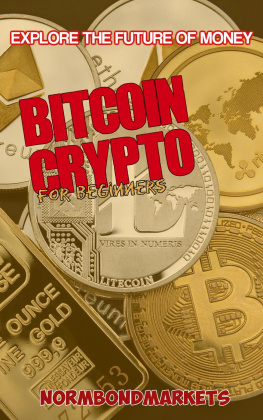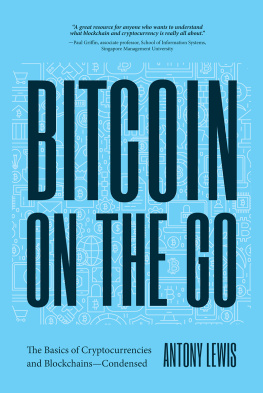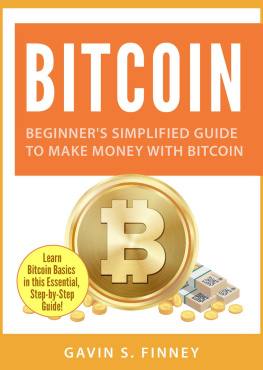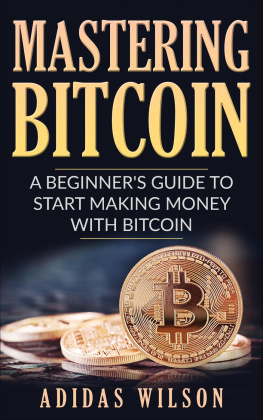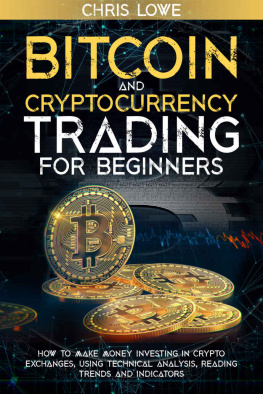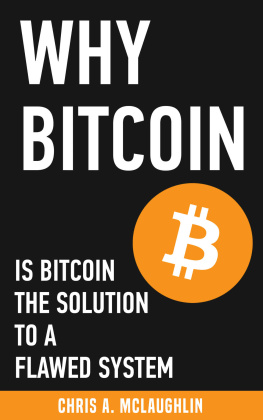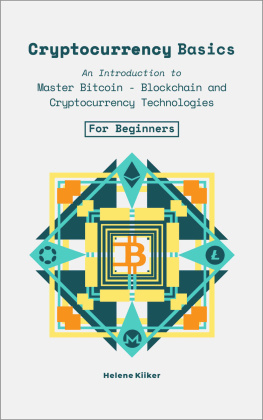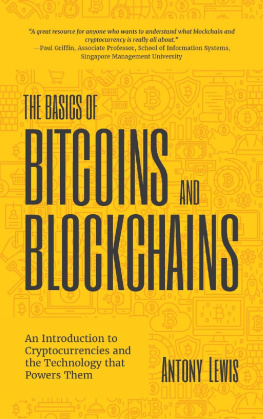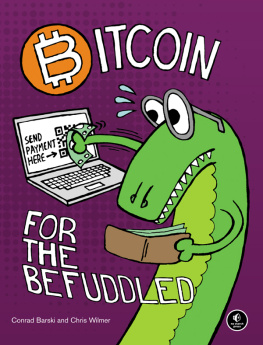Bitcoin and Crypto for Beginners
Norm Bond
Published by Norm Bond, 2020.
While every precaution has been taken in the preparation of this book, the publisher assumes no responsibility for errors or omissions, or for damages resulting from the use of the information contained herein.
BITCOIN AND CRYPTO FOR BEGINNERS
First edition. September 18, 2020.
Copyright 2020 Norm Bond.
ISBN: 978-1393984177
Written by Norm Bond.
10 9 8 7 6 5 4 3 2 1

Chapter 1: Introduction - Lets Begin
C ryptocurrency is often referred to as the future of money. If youre new to this you probably wonder what does that mean? You may have noticed the decline in the use of cash. Many people dont carry it or just a bare minimum. In our digital age we can pay electronically. We use cards whether they are credit, debit, gift, or store cards. We use mobile devices and we shop online for curbside pickup. Times have changed and continue to evolve.
Here in Asia where Im based it is common to tap your phone at checkout counters. Cryptocurrency builds further on this evolution, and the king of cryptocurrency is bitcoin.
It has never been more popular than now. Demand increases as more people understand the benefits and opportunities it presents. Were going to cover this and more in this Ebook. Im glad you decided to give it a read.
What is a cryptocurrency? Broadly defined, cryptocurrency is virtual or digital money which takes the form of tokens or coins.
Since cryptocurrency is digital money there is no physical coin or bill its all online. You can transfer cryptocurrency to someone online without a go-between, like a bank or credit card company. The so called, third-party is eliminated. This is huge.
If crypto makes you think cryptic, secret, clandestine or hidden youre in the right mindset. The root of this concept is codes and code-breaking. Cryptography allows for the complex creation and processing of digital currencies and their transactions across decentralized systems.
Currency brings to mind cash, moolah, money, bling-bling. Smash it together and we have crypto-currency. The actual technical definition is not much deeper than that. Cryptography meaning the act of writing and solving codes, and currency meaning a medium of exchange.
Cryptocurrency then is a medium of exchange dependent on a series of codes.
On October 31, 2008, a design paper was shared to a cryptography mailing list by someone using the name Satoshi Nakamoto. The publication titled Bitcoin: A Peer-to-Peer Electronic Cash System sparked the imagination and gained wide support, debate and discussion within the group. Bitcoin was out of the box. (See the Resources Chapter for a link to the original white paper)
Sounds real James Bond right? Stick with me here. People in cryptography circles are basically code-breakers. Throughout history, military and society messages have needed to be passed in secret. Spies and codes bring intrigue, mystery and play a vital role in development.
When Satoshi dropped this bomb of a report introducing Bitcoin, both a new coding protocol and a digital currency, it grabbed the attention of the programmers like a stack of hot pizzas.
The members seized on it, challenged it, expanded it and worked collectively to establish a foothold. Their early work brings us to where we are now. Today we have a digital currency that trades in excess of $10,000 USD per coin.
In addition, the Bitcoin protocol or blockchain technology, is being tested or implemented across almost every industry on the planet. Let that sink in for a minute.
This story is more intriguing because in 2008 Satoshi and crew were practically giving away bitcoins. Consider the first commercial bitcoin transaction. On May 22, 2010 a coder bought two pizzas for 10,000 bitcoins. Laszlo Hanyecz was recently interviewed and said he had no regrets.

Bitcoin is not the only cryptocurrency, there are thousands. According to CoinMarketCap , a popular source to track crypto growth and prices, the total number of cryptocurrencies is 6,955 with a total market cap of $324.716 billion (as of September 9, 2020).
Bitcoin trades as BTC and is the oldest and largest cryptocurrency. Everything else is typically referred to as an altcoin. That is an alternative to Bitcoin and these coins are tied to various projects and use cases. Some work with bitcoin while others seek to challenge and replace bitcoin as the dominant crypto in the marketplace.
OK dear reader, that is enough of an introduction. Were going to cover more in the chapters to follow.
My style is to keep all of the content informative but not overly technical. There are plenty of sources for more technical, lengthy and detailed data.
I share lots of information for expanded learning in the Resources Chapter section of this Ebook. Be sure to check it out. But as our focus is beginners dont expect to go overly technical or lengthy in any of our work.
See you in the next chapter.

Chapter 2: What is Bitcoin?
I n this chapter were going to dive into understanding the what is of bitcoin. Even people with strong financial backgrounds that span decades are not clear on the answer to this question. By seeking to learn more about this topic you are separating yourself further from the masses. You are positioning yourself as a leader. And you may find yourself walking a path to riches if that is something that strikes your fancy.
Bitcoin is both a digital currency and a technological system. By understanding each of these aspects you will be able to determine where you want to focus your efforts.
I mentioned earlier that the Bitcoin technological system is known as blockchain. A block is basically a storage unit. It holds records of data. This data relates to transactions that happened and includes fields like date, time, and dollar amount. Blocks also include something called a hash. This enables each block to be unique. Remember a chain of blocks is a sequenced collection of these storage units or blockchain.
From a business perspective, we can think of this blockchain technology as next-gen process improvement software. It is disruptive of traditional methods of operating.
Why is this? One of the key elements is the collaborative nature of the technology. Blockchain connects computers on a peer-to-peer basis. In other words, all of the computers on the network are equals. This contrasts with a hierarchical or centralized system where there is one dominant host or mainframe. If the dominant host goes down the entire network crashes.

